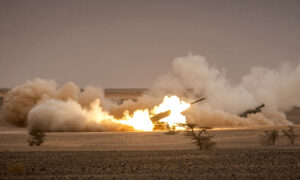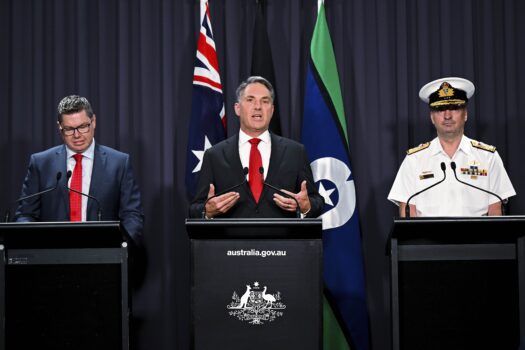More Missiles, Less Armoured Vehicles: ADF Continues Evolution to Deal With Beijing Threat
Australia will cut the purchase of new armoured vehicles in favour of long-range missiles to better deal with the Beijing threat and pivot the country’s military from a land-based fighting force to one better suited to maritime warfare. On April 24, the Labor government received the final report from a defence review ordered in August last year and following an earlier overhaul of the Australian Defence Force under the Morrison government. Defence Industry Minister Pat Conroy said the current emphasis was on “deterrence” and a greater effort to contribute to the collective security of the region. “We need to significantly reshape the Australian Defence Force (ADF) and how we do defence policy more generally to face that uncertainty,” he told ABC Radio. (L–R) Australian Defense Industry Minister Pat Conroy, Australian Deputy Prime Minister Richard Marles, and head of the Nuclear Powered Submarine Task Force Vice Adm. Jonathan Mead speak to the media during a press conference at Parliament House in Canberra, Australia, on March 14, 2023. (Lukas Coch/AAP Image via AP) What Changes Are in Store? The review has already earmarked cutting the number of infantry fighting vehicles on order from 450 to 129, with a regiment of self-propelled howitzers to be cancelled. Conroy said the funding that will be freed up will be invested in long-range strike power for the ADF. “More HIMARS rocket systems and land-based maritime strike,” he said, adding that the government would also purchase extra landing craft. “So this is about getting an Australian army that’s shaped for our current strategic circumstances and going from a service whose greatest range for its artillery are 45 kilometres to one that can project power in excess of 500 kilometres. So this is about reshaping the army to modernise it, to be quite frank,” he said. Other recommendations include acquiring land-based missile launchers primed for hitting naval targets. Experts have previously called for Australia to adapt to potential conflict in its immediate region. The ADF has spent the last two decades engaged largely in the desert conflict in the Middle East, along with the United States, where tanks and land warfare play a major role. But the build-up of the Chinese People’s Liberation Army in the Taiwan Strait and South China Sea has forced military planners to look at how to better operate in maritime environments comprised largely of islands. “Many commentators have called for the ADF to be structured along the same lines as the U.S. Marine Corps, specifically a Marine Expeditionary Force. Therefore, spending billions of dollars on Abrams tanks and 400 infantry fighting vehicles does not make sense,” said Lincoln Parker, chair of the Liberal Party’s Defence and National Security Branch, in an earlier interview with The Epoch Times. Procurement an Ongoing Issue Meanwhile, Conroy has vowed to also deal with acquisition and procurement problems in the ADF. “The Albanese government is committed to making the hard decisions, and that means making necessary changes to scope out and the example that’s out there already is us accepting the recommendation of the strategic review to reshape the Australian army,” he said. Parker, who is involved in defence technology innovation, said the ADF needed a “complete culture change and mindset adjustment.” “The Department of Defence is mired in bureaucracy, red tape, procedures and a monstrous aversion to any form of risk. How do you procure anything quickly, let alone innovate, under this cultural malaise?” he said. “The answer you don’t. This is why Australia’s defence bang for the buck is one of the world’s worst.” Read MoreNo More Reviews: Veteran Affairs Advocate Says Defence Force Needs Overhaul

Australia will cut the purchase of new armoured vehicles in favour of long-range missiles to better deal with the Beijing threat and pivot the country’s military from a land-based fighting force to one better suited to maritime warfare.
On April 24, the Labor government received the final report from a defence review ordered in August last year and following an earlier overhaul of the Australian Defence Force under the Morrison government.
Defence Industry Minister Pat Conroy said the current emphasis was on “deterrence” and a greater effort to contribute to the collective security of the region.
“We need to significantly reshape the Australian Defence Force (ADF) and how we do defence policy more generally to face that uncertainty,” he told ABC Radio.

What Changes Are in Store?
The review has already earmarked cutting the number of infantry fighting vehicles on order from 450 to 129, with a regiment of self-propelled howitzers to be cancelled.
Conroy said the funding that will be freed up will be invested in long-range strike power for the ADF.
“More HIMARS rocket systems and land-based maritime strike,” he said, adding that the government would also purchase extra landing craft.
“So this is about getting an Australian army that’s shaped for our current strategic circumstances and going from a service whose greatest range for its artillery are 45 kilometres to one that can project power in excess of 500 kilometres. So this is about reshaping the army to modernise it, to be quite frank,” he said.
Other recommendations include acquiring land-based missile launchers primed for hitting naval targets.
Experts have previously called for Australia to adapt to potential conflict in its immediate region.
The ADF has spent the last two decades engaged largely in the desert conflict in the Middle East, along with the United States, where tanks and land warfare play a major role.
But the build-up of the Chinese People’s Liberation Army in the Taiwan Strait and South China Sea has forced military planners to look at how to better operate in maritime environments comprised largely of islands.
“Many commentators have called for the ADF to be structured along the same lines as the U.S. Marine Corps, specifically a Marine Expeditionary Force. Therefore, spending billions of dollars on Abrams tanks and 400 infantry fighting vehicles does not make sense,” said Lincoln Parker, chair of the Liberal Party’s Defence and National Security Branch, in an earlier interview with The Epoch Times.
Procurement an Ongoing Issue
Meanwhile, Conroy has vowed to also deal with acquisition and procurement problems in the ADF.
“The Albanese government is committed to making the hard decisions, and that means making necessary changes to scope out and the example that’s out there already is us accepting the recommendation of the strategic review to reshape the Australian army,” he said.
Parker, who is involved in defence technology innovation, said the ADF needed a “complete culture change and mindset adjustment.”
“The Department of Defence is mired in bureaucracy, red tape, procedures and a monstrous aversion to any form of risk. How do you procure anything quickly, let alone innovate, under this cultural malaise?” he said.
“The answer you don’t. This is why Australia’s defence bang for the buck is one of the world’s worst.”












